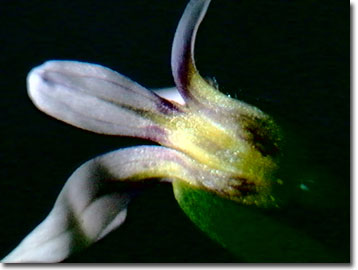Reflected Light Digital Image Gallery
Lavender Wildflower
One person's weeds are another's wildflowers. Often found in urban settings and other disturbed ecosystems, many weed species thrive in small niches such as sidewalk cracks and spaces in brickwork.

View a second image of a Lavender Wildflower.
View a third image of a Lavender Wildflower.
Weeds in North America are often exotics introduced to the continent from Europe, Asia, Africa, or South America into an ecosystem that offers little competition or predation. Some exotic plants become formidable problems, such as the invasive kudzu in the Southeastern United States, which strangles and shades native species, and causes economic damage to power lines, transformers, and telephone cables. Others, like the small herbaceous plant illustrated here, is found throughout the City of Tallahassee, Florida, but because of its low growing habit and nature of occupying disturbed edge areas near sidewalks and pathways, suffers from benign neglect.
The lavender petals of the flower illustrate the radial symmetry typical of many angiosperm species. Blue or lavender pigments are created to attract insect pollinators. Typically, a flower that is pink, blue or yellow, with a narrow opening or tube, as this flower exhibits, invites pollination by butterflies, while other flowers featuring bilateral symmetry are visited by bees. The color attributed to the petal is that perceived by the human visual system, but the same flower may appear to a honeybee, butterfly, beetle, or hummingbird as a bulls-eye pattern in various shades of ultraviolet. The shape of the flower, its aroma, the season of inflorescence, and the quality and quantity of its nectar or pollen also help ensure that the type of pollinator attracted will be most favorable to the success of the flowering plant's genes.
Contributing Authors
Cynthia D. Kelly, Thomas J. Fellers and Michael W. Davidson - National High Magnetic Field Laboratory, 1800 East Paul Dirac Dr., The Florida State University, Tallahassee, Florida, 32310.
BACK TO THE REFLECTED LIGHT IMAGE GALLERY
BACK TO THE DIGITAL IMAGE GALLERIES
Questions or comments? Send us an email.
© 1995-2025 by Michael W. Davidson and The Florida State University. All Rights Reserved. No images, graphics, software, scripts, or applets may be reproduced or used in any manner without permission from the copyright holders. Use of this website means you agree to all of the Legal Terms and Conditions set forth by the owners.
This website is maintained by our
Graphics & Web Programming Team
in collaboration with Optical Microscopy at the
National High Magnetic Field Laboratory.
Last Modification Friday, Nov 13, 2015 at 01:19 PM
Access Count Since September 17, 2002: 7827
Visit the website of our partner in introductory microscopy education:
|
|
